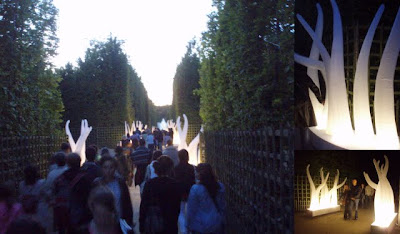Of course there were the typical fruit stands as well.
The produce looked fabulous. We bought a carton of raspberries and they were deliciously sweet and not too tart.
We then walked up Rue des Renaudes and got a great view of the Cathédrale St. Alexandre Nevsky, a Russian-Orthodox church.
The church was completed in 1861. Pablo Picasso married Olga Khokhlova here in 1918.
The Rue Daru is the heart of the small Russian quarter. The sign for this shop was written in French and Russian/Cyrillic. Down the street, another shop had a matryoshka nesting doll as part of its logo.
I love coming to this park and people watching. You are allowed to sit on the grassy areas and lots of people come here on their lunch break if it's a nice day. Today we saw people lounging, exercising, and even painting.
Today there were pony rides for the kids as well.
There are several Belle Epoque monuments to French writers and musicians; this one is dedicated to Guy de Maupassant, accompanied by a fashionably-dressed Muse.
Some romantic century "ruins" (follies created just for the park) provide charming photo-ops:
From the park we ambled leisurely along until we arrived at the Musée Jacquemart-André, a gorgeous mansion, sumptuously decorated and chock-full of antiquities and art.
Edouard André married socialite Nélie Jacquemart and they spent part of each year in Italy, collecting priceless artworks which they used to decorate their home in Paris. After Edouard died, Nélie continued to acquire pieces from Italy and the orient until her death, when the house and everything in it was bequeathed to the Institut de France as a museum, which opened in 1913.
| Edouard André in military dress, by Franz-Xavier Winterhalter |
I will warn you that my photos don't really do this place justice; for "perfect" photos of every room, visit the very informative main website. We don't always do the audio tour at museums but it really came in handy here, since there is just so much to see.
The Salon des Peintures was beautifully decorated with portraits and priceless paintings.
I liked the way they illuminated the busts in the Grand Salon, where the Andrés received their guests at formal functions. This bust of the architect Jacques Gabriel by Antoine Coysevox was exceptionally striking; I think it's the hair.
The Salon des Tapisseries had lavish tapestries hanging on the walls, such as this Beauvais tapestry.
The Cabinet de Travail (work room) had some exceptional pieces, such as this Les Débuts du Modèle (The Model's Debut) by Jean-Honoré Fragonard (center)...
... and this ceiling by the Venetian painter Giambattista Tiepolo, called l'Apothéose d'Hercule.
In the Boudoir was this gorgeous Élisabeth Vigée Le Brun, the Portrait of Countess Catherine Skavronskaia.
The library contained an incredible collection of Dutch masters...
...including Rembrandt's Portrait of Doctor Arnold Tholinx.
The music room was enormous, with moveable walls to accommodate large parties and dancing.
The ceiling of the room was open to the 2nd floor, with its frescoed ceiling.
Bored yet? If so, skip to the next post, since it's all about rollercoasters and amusement park rides. Otherwise, let's continue with the tour to the Winter Garden and its ornate marble staircase....
...topped by another Tiepolo fresco.
I had never heard of the artist Carlo Crivelli, but the lines and colors in these portraits of various saints (painted in the late 1400's) were as vibrant as if they were painted yesterday.
An amateur painter herself, it's no wonder she was such a passionate collector of art.
| Center painting on easel is by N. Jacquemart-André |
Exhausted and a little overwhelmed, we left the museum and finished up our walk at the Church of Saint Philippe du Roule. It's notable because it was designed in the late 1700's by the architect Jean Chalgrin, who also designed Napoleon's Arc de Triomphe.
We did not spend much time in the church, but I thought the semicircular nave and columns was pretty, and very different from the gothic churches we've been seeing.







